Business Law Case Study: Claims of Negligence and Contract Breaches
VerifiedAdded on 2023/06/04
|8
|2124
|113
Case Study
AI Summary
This case study analyzes several legal issues arising from Ellen's business venture. Issue 1 explores whether Ellen has a claim against the council for negligent guidance, examining misrepresentation and duty of care, ultimately suggesting a negligence claim is viable. Issue 2 addresses a potential breach of contract between Ellen and her landlord due to non-payment of rent, concluding that Ellen is indeed in breach. Issue 3 investigates whether the council employee made a negligent misstatement, determining that the elements of negligent misstatement are present. The study recommends Ellen pursue claims of negligence and negligent misstatement against the council to seek compensation for her losses.
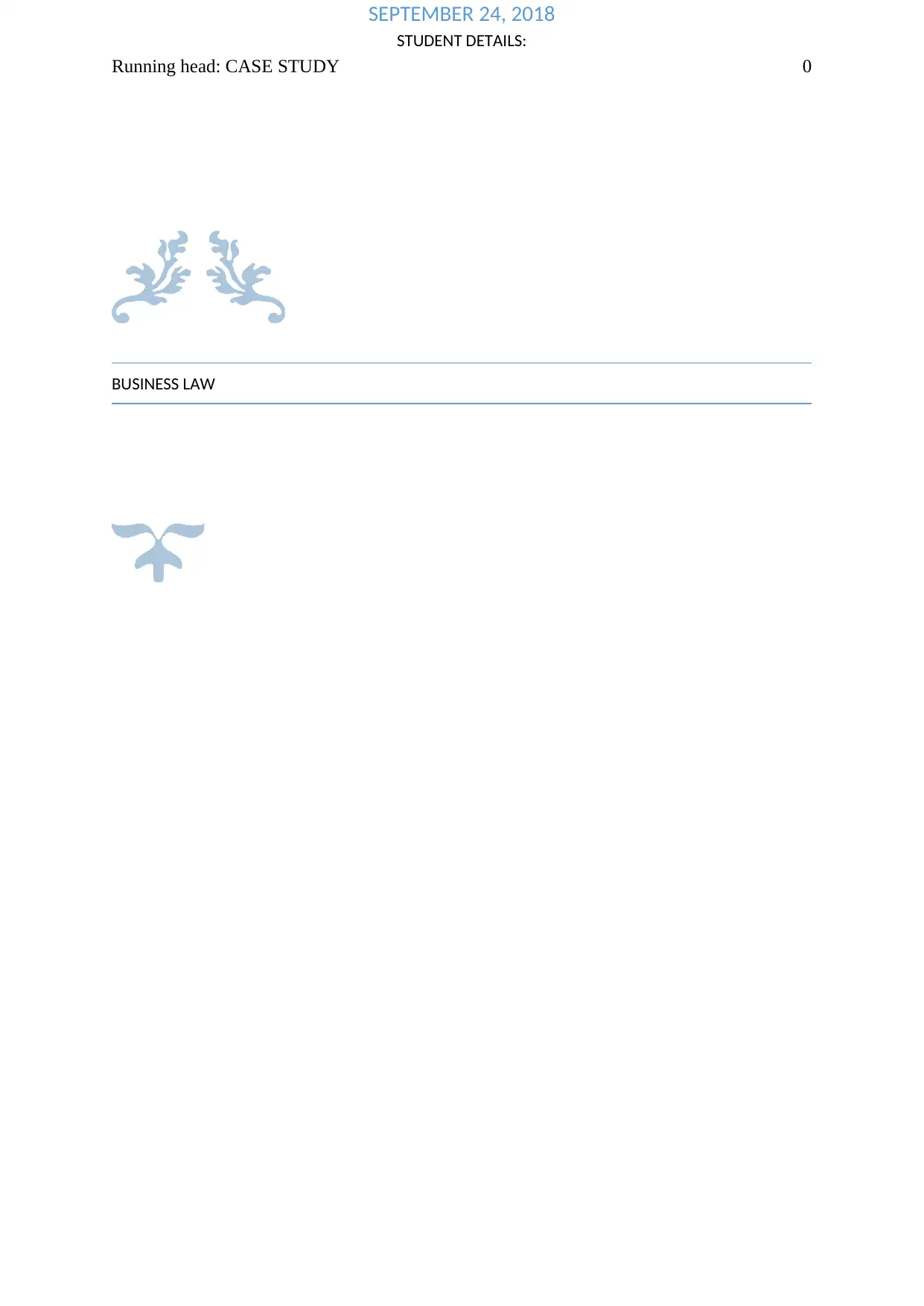
Running head: CASE STUDY 0
BUSINESS LAW
SEPTEMBER 24, 2018
STUDENT DETAILS:
BUSINESS LAW
SEPTEMBER 24, 2018
STUDENT DETAILS:
Paraphrase This Document
Need a fresh take? Get an instant paraphrase of this document with our AI Paraphraser
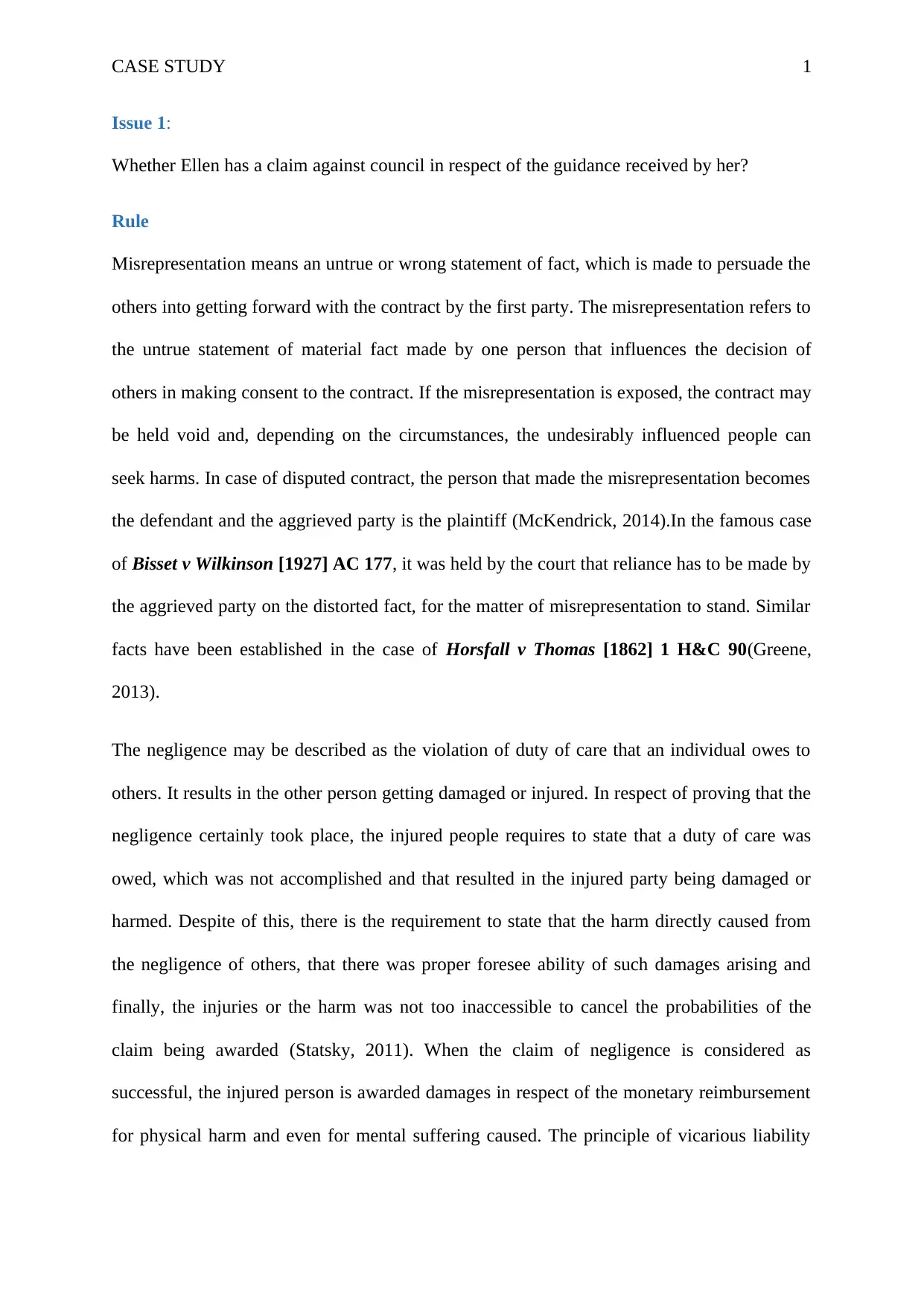
CASE STUDY 1
Issue 1:
Whether Ellen has a claim against council in respect of the guidance received by her?
Rule
Misrepresentation means an untrue or wrong statement of fact, which is made to persuade the
others into getting forward with the contract by the first party. The misrepresentation refers to
the untrue statement of material fact made by one person that influences the decision of
others in making consent to the contract. If the misrepresentation is exposed, the contract may
be held void and, depending on the circumstances, the undesirably influenced people can
seek harms. In case of disputed contract, the person that made the misrepresentation becomes
the defendant and the aggrieved party is the plaintiff (McKendrick, 2014).In the famous case
of Bisset v Wilkinson [1927] AC 177, it was held by the court that reliance has to be made by
the aggrieved party on the distorted fact, for the matter of misrepresentation to stand. Similar
facts have been established in the case of Horsfall v Thomas [1862] 1 H&C 90(Greene,
2013).
The negligence may be described as the violation of duty of care that an individual owes to
others. It results in the other person getting damaged or injured. In respect of proving that the
negligence certainly took place, the injured people requires to state that a duty of care was
owed, which was not accomplished and that resulted in the injured party being damaged or
harmed. Despite of this, there is the requirement to state that the harm directly caused from
the negligence of others, that there was proper foresee ability of such damages arising and
finally, the injuries or the harm was not too inaccessible to cancel the probabilities of the
claim being awarded (Statsky, 2011). When the claim of negligence is considered as
successful, the injured person is awarded damages in respect of the monetary reimbursement
for physical harm and even for mental suffering caused. The principle of vicarious liability
Issue 1:
Whether Ellen has a claim against council in respect of the guidance received by her?
Rule
Misrepresentation means an untrue or wrong statement of fact, which is made to persuade the
others into getting forward with the contract by the first party. The misrepresentation refers to
the untrue statement of material fact made by one person that influences the decision of
others in making consent to the contract. If the misrepresentation is exposed, the contract may
be held void and, depending on the circumstances, the undesirably influenced people can
seek harms. In case of disputed contract, the person that made the misrepresentation becomes
the defendant and the aggrieved party is the plaintiff (McKendrick, 2014).In the famous case
of Bisset v Wilkinson [1927] AC 177, it was held by the court that reliance has to be made by
the aggrieved party on the distorted fact, for the matter of misrepresentation to stand. Similar
facts have been established in the case of Horsfall v Thomas [1862] 1 H&C 90(Greene,
2013).
The negligence may be described as the violation of duty of care that an individual owes to
others. It results in the other person getting damaged or injured. In respect of proving that the
negligence certainly took place, the injured people requires to state that a duty of care was
owed, which was not accomplished and that resulted in the injured party being damaged or
harmed. Despite of this, there is the requirement to state that the harm directly caused from
the negligence of others, that there was proper foresee ability of such damages arising and
finally, the injuries or the harm was not too inaccessible to cancel the probabilities of the
claim being awarded (Statsky, 2011). When the claim of negligence is considered as
successful, the injured person is awarded damages in respect of the monetary reimbursement
for physical harm and even for mental suffering caused. The principle of vicarious liability
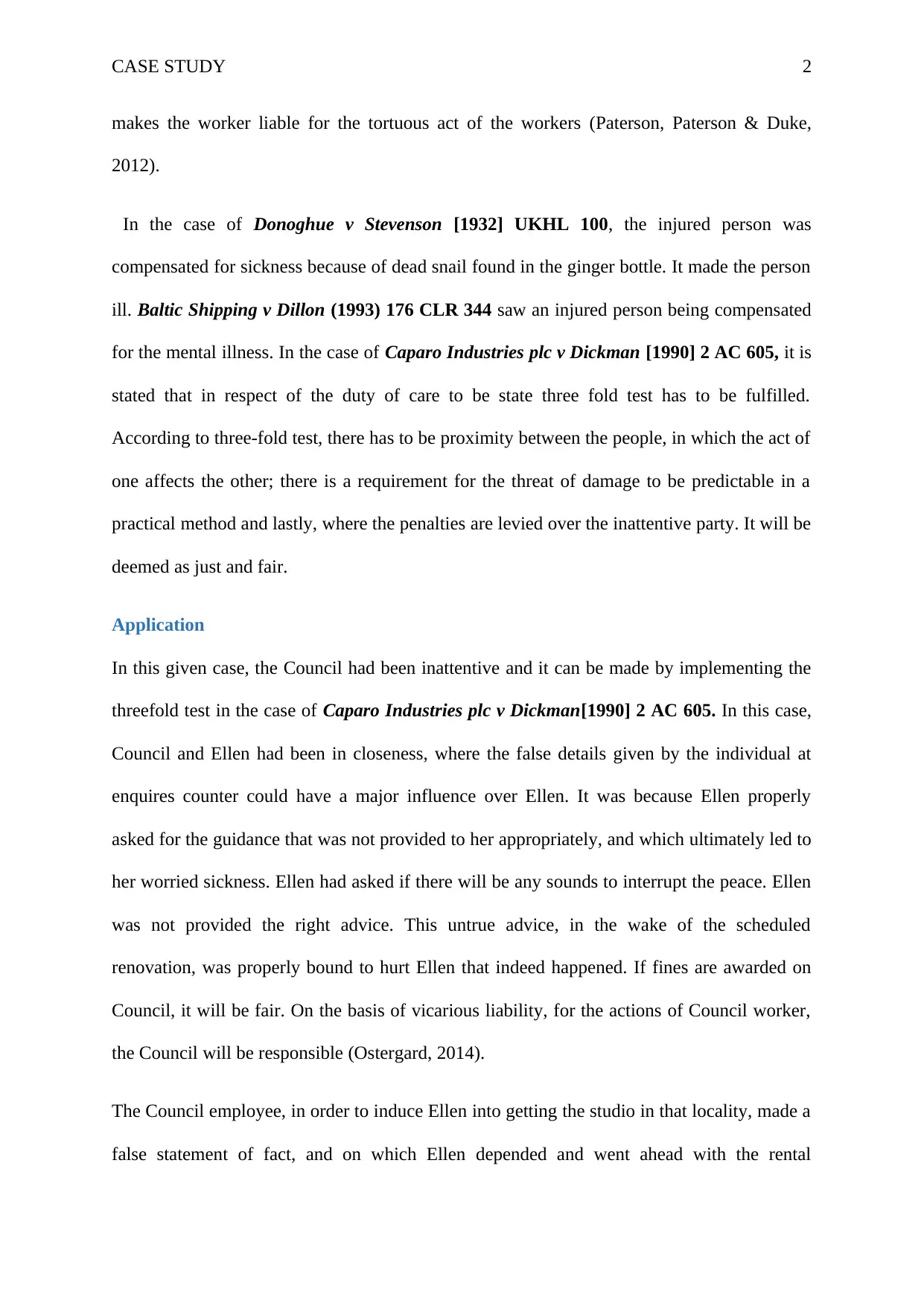
CASE STUDY 2
makes the worker liable for the tortuous act of the workers (Paterson, Paterson & Duke,
2012).
In the case of Donoghue v Stevenson [1932] UKHL 100, the injured person was
compensated for sickness because of dead snail found in the ginger bottle. It made the person
ill. Baltic Shipping v Dillon (1993) 176 CLR 344 saw an injured person being compensated
for the mental illness. In the case of Caparo Industries plc v Dickman [1990] 2 AC 605, it is
stated that in respect of the duty of care to be state three fold test has to be fulfilled.
According to three-fold test, there has to be proximity between the people, in which the act of
one affects the other; there is a requirement for the threat of damage to be predictable in a
practical method and lastly, where the penalties are levied over the inattentive party. It will be
deemed as just and fair.
Application
In this given case, the Council had been inattentive and it can be made by implementing the
threefold test in the case of Caparo Industries plc v Dickman[1990] 2 AC 605. In this case,
Council and Ellen had been in closeness, where the false details given by the individual at
enquires counter could have a major influence over Ellen. It was because Ellen properly
asked for the guidance that was not provided to her appropriately, and which ultimately led to
her worried sickness. Ellen had asked if there will be any sounds to interrupt the peace. Ellen
was not provided the right advice. This untrue advice, in the wake of the scheduled
renovation, was properly bound to hurt Ellen that indeed happened. If fines are awarded on
Council, it will be fair. On the basis of vicarious liability, for the actions of Council worker,
the Council will be responsible (Ostergard, 2014).
The Council employee, in order to induce Ellen into getting the studio in that locality, made a
false statement of fact, and on which Ellen depended and went ahead with the rental
makes the worker liable for the tortuous act of the workers (Paterson, Paterson & Duke,
2012).
In the case of Donoghue v Stevenson [1932] UKHL 100, the injured person was
compensated for sickness because of dead snail found in the ginger bottle. It made the person
ill. Baltic Shipping v Dillon (1993) 176 CLR 344 saw an injured person being compensated
for the mental illness. In the case of Caparo Industries plc v Dickman [1990] 2 AC 605, it is
stated that in respect of the duty of care to be state three fold test has to be fulfilled.
According to three-fold test, there has to be proximity between the people, in which the act of
one affects the other; there is a requirement for the threat of damage to be predictable in a
practical method and lastly, where the penalties are levied over the inattentive party. It will be
deemed as just and fair.
Application
In this given case, the Council had been inattentive and it can be made by implementing the
threefold test in the case of Caparo Industries plc v Dickman[1990] 2 AC 605. In this case,
Council and Ellen had been in closeness, where the false details given by the individual at
enquires counter could have a major influence over Ellen. It was because Ellen properly
asked for the guidance that was not provided to her appropriately, and which ultimately led to
her worried sickness. Ellen had asked if there will be any sounds to interrupt the peace. Ellen
was not provided the right advice. This untrue advice, in the wake of the scheduled
renovation, was properly bound to hurt Ellen that indeed happened. If fines are awarded on
Council, it will be fair. On the basis of vicarious liability, for the actions of Council worker,
the Council will be responsible (Ostergard, 2014).
The Council employee, in order to induce Ellen into getting the studio in that locality, made a
false statement of fact, and on which Ellen depended and went ahead with the rental
⊘ This is a preview!⊘
Do you want full access?
Subscribe today to unlock all pages.

Trusted by 1+ million students worldwide
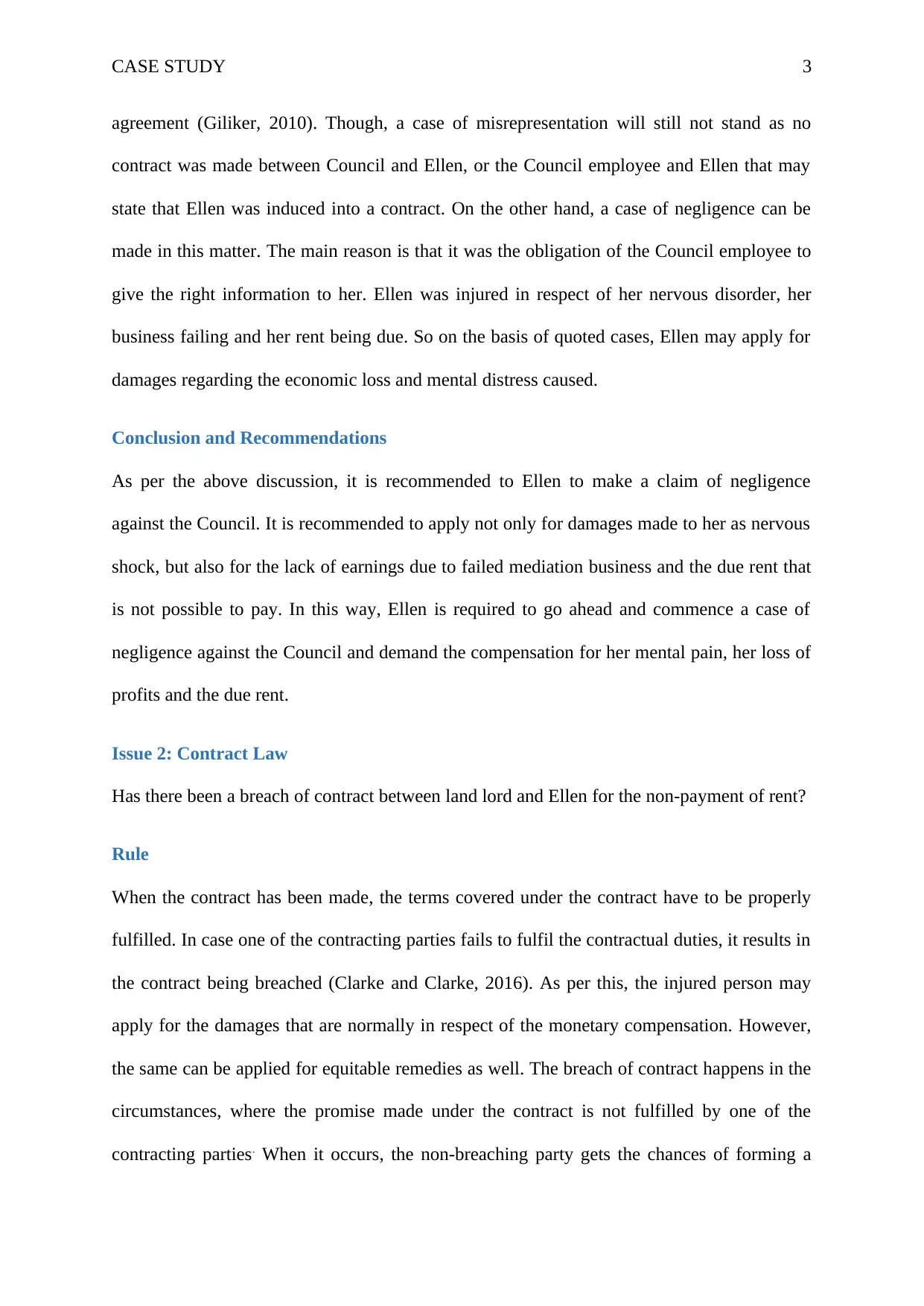
CASE STUDY 3
agreement (Giliker, 2010). Though, a case of misrepresentation will still not stand as no
contract was made between Council and Ellen, or the Council employee and Ellen that may
state that Ellen was induced into a contract. On the other hand, a case of negligence can be
made in this matter. The main reason is that it was the obligation of the Council employee to
give the right information to her. Ellen was injured in respect of her nervous disorder, her
business failing and her rent being due. So on the basis of quoted cases, Ellen may apply for
damages regarding the economic loss and mental distress caused.
Conclusion and Recommendations
As per the above discussion, it is recommended to Ellen to make a claim of negligence
against the Council. It is recommended to apply not only for damages made to her as nervous
shock, but also for the lack of earnings due to failed mediation business and the due rent that
is not possible to pay. In this way, Ellen is required to go ahead and commence a case of
negligence against the Council and demand the compensation for her mental pain, her loss of
profits and the due rent.
Issue 2: Contract Law
Has there been a breach of contract between land lord and Ellen for the non-payment of rent?
Rule
When the contract has been made, the terms covered under the contract have to be properly
fulfilled. In case one of the contracting parties fails to fulfil the contractual duties, it results in
the contract being breached (Clarke and Clarke, 2016). As per this, the injured person may
apply for the damages that are normally in respect of the monetary compensation. However,
the same can be applied for equitable remedies as well. The breach of contract happens in the
circumstances, where the promise made under the contract is not fulfilled by one of the
contracting parties. When it occurs, the non-breaching party gets the chances of forming a
agreement (Giliker, 2010). Though, a case of misrepresentation will still not stand as no
contract was made between Council and Ellen, or the Council employee and Ellen that may
state that Ellen was induced into a contract. On the other hand, a case of negligence can be
made in this matter. The main reason is that it was the obligation of the Council employee to
give the right information to her. Ellen was injured in respect of her nervous disorder, her
business failing and her rent being due. So on the basis of quoted cases, Ellen may apply for
damages regarding the economic loss and mental distress caused.
Conclusion and Recommendations
As per the above discussion, it is recommended to Ellen to make a claim of negligence
against the Council. It is recommended to apply not only for damages made to her as nervous
shock, but also for the lack of earnings due to failed mediation business and the due rent that
is not possible to pay. In this way, Ellen is required to go ahead and commence a case of
negligence against the Council and demand the compensation for her mental pain, her loss of
profits and the due rent.
Issue 2: Contract Law
Has there been a breach of contract between land lord and Ellen for the non-payment of rent?
Rule
When the contract has been made, the terms covered under the contract have to be properly
fulfilled. In case one of the contracting parties fails to fulfil the contractual duties, it results in
the contract being breached (Clarke and Clarke, 2016). As per this, the injured person may
apply for the damages that are normally in respect of the monetary compensation. However,
the same can be applied for equitable remedies as well. The breach of contract happens in the
circumstances, where the promise made under the contract is not fulfilled by one of the
contracting parties. When it occurs, the non-breaching party gets the chances of forming a
Paraphrase This Document
Need a fresh take? Get an instant paraphrase of this document with our AI Paraphraser
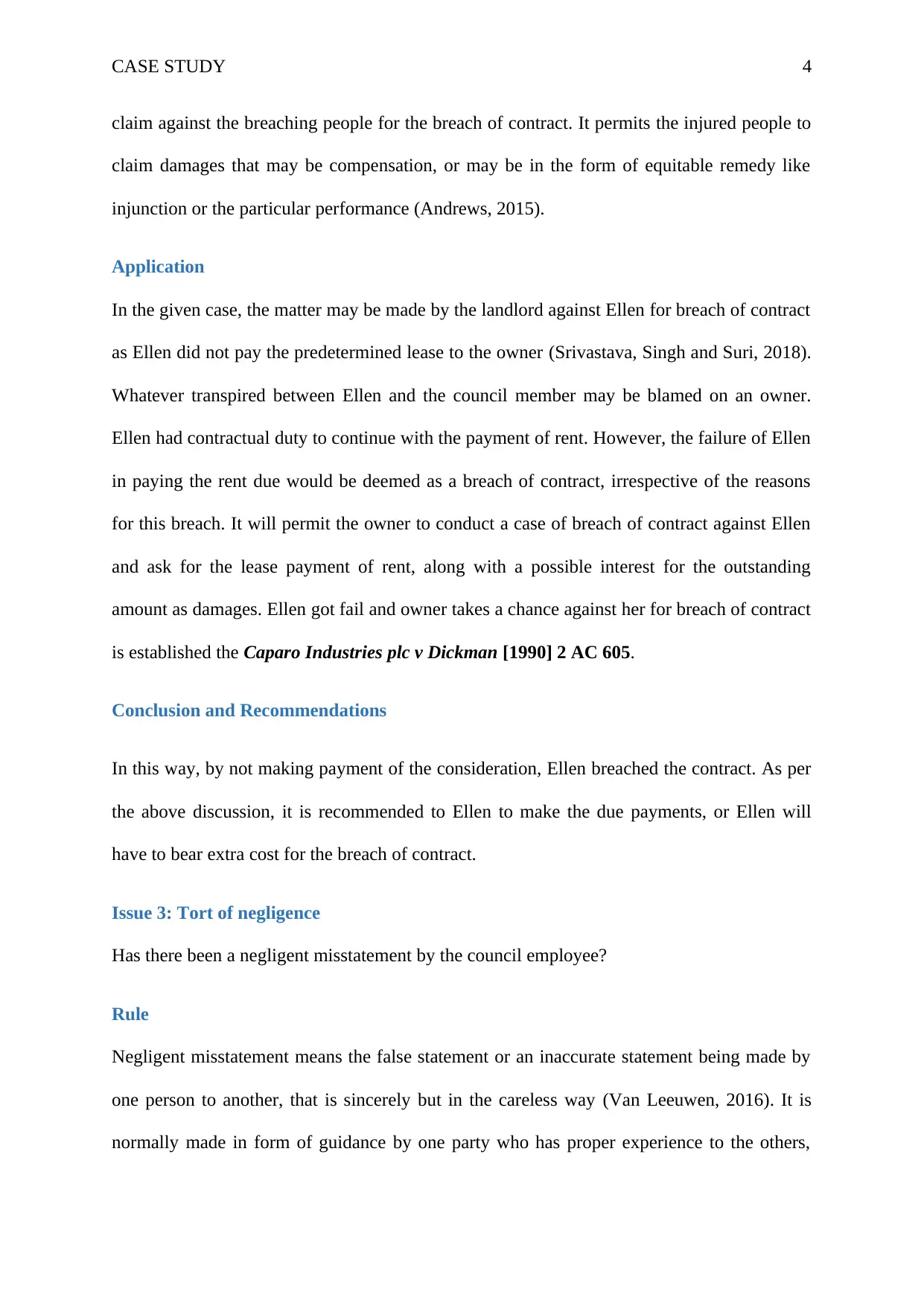
CASE STUDY 4
claim against the breaching people for the breach of contract. It permits the injured people to
claim damages that may be compensation, or may be in the form of equitable remedy like
injunction or the particular performance (Andrews, 2015).
Application
In the given case, the matter may be made by the landlord against Ellen for breach of contract
as Ellen did not pay the predetermined lease to the owner (Srivastava, Singh and Suri, 2018).
Whatever transpired between Ellen and the council member may be blamed on an owner.
Ellen had contractual duty to continue with the payment of rent. However, the failure of Ellen
in paying the rent due would be deemed as a breach of contract, irrespective of the reasons
for this breach. It will permit the owner to conduct a case of breach of contract against Ellen
and ask for the lease payment of rent, along with a possible interest for the outstanding
amount as damages. Ellen got fail and owner takes a chance against her for breach of contract
is established the Caparo Industries plc v Dickman [1990] 2 AC 605.
Conclusion and Recommendations
In this way, by not making payment of the consideration, Ellen breached the contract. As per
the above discussion, it is recommended to Ellen to make the due payments, or Ellen will
have to bear extra cost for the breach of contract.
Issue 3: Tort of negligence
Has there been a negligent misstatement by the council employee?
Rule
Negligent misstatement means the false statement or an inaccurate statement being made by
one person to another, that is sincerely but in the careless way (Van Leeuwen, 2016). It is
normally made in form of guidance by one party who has proper experience to the others,
claim against the breaching people for the breach of contract. It permits the injured people to
claim damages that may be compensation, or may be in the form of equitable remedy like
injunction or the particular performance (Andrews, 2015).
Application
In the given case, the matter may be made by the landlord against Ellen for breach of contract
as Ellen did not pay the predetermined lease to the owner (Srivastava, Singh and Suri, 2018).
Whatever transpired between Ellen and the council member may be blamed on an owner.
Ellen had contractual duty to continue with the payment of rent. However, the failure of Ellen
in paying the rent due would be deemed as a breach of contract, irrespective of the reasons
for this breach. It will permit the owner to conduct a case of breach of contract against Ellen
and ask for the lease payment of rent, along with a possible interest for the outstanding
amount as damages. Ellen got fail and owner takes a chance against her for breach of contract
is established the Caparo Industries plc v Dickman [1990] 2 AC 605.
Conclusion and Recommendations
In this way, by not making payment of the consideration, Ellen breached the contract. As per
the above discussion, it is recommended to Ellen to make the due payments, or Ellen will
have to bear extra cost for the breach of contract.
Issue 3: Tort of negligence
Has there been a negligent misstatement by the council employee?
Rule
Negligent misstatement means the false statement or an inaccurate statement being made by
one person to another, that is sincerely but in the careless way (Van Leeuwen, 2016). It is
normally made in form of guidance by one party who has proper experience to the others,
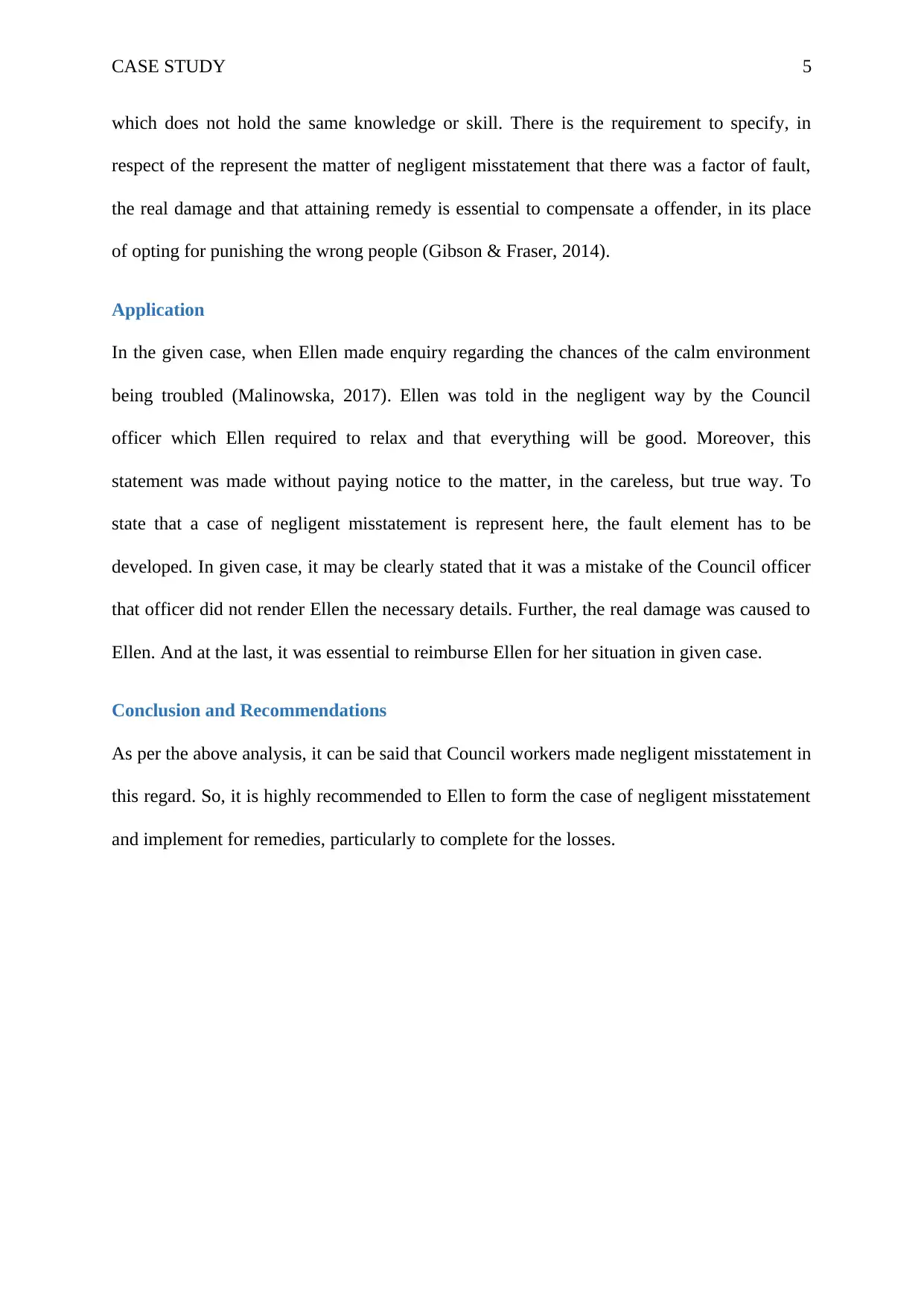
CASE STUDY 5
which does not hold the same knowledge or skill. There is the requirement to specify, in
respect of the represent the matter of negligent misstatement that there was a factor of fault,
the real damage and that attaining remedy is essential to compensate a offender, in its place
of opting for punishing the wrong people (Gibson & Fraser, 2014).
Application
In the given case, when Ellen made enquiry regarding the chances of the calm environment
being troubled (Malinowska, 2017). Ellen was told in the negligent way by the Council
officer which Ellen required to relax and that everything will be good. Moreover, this
statement was made without paying notice to the matter, in the careless, but true way. To
state that a case of negligent misstatement is represent here, the fault element has to be
developed. In given case, it may be clearly stated that it was a mistake of the Council officer
that officer did not render Ellen the necessary details. Further, the real damage was caused to
Ellen. And at the last, it was essential to reimburse Ellen for her situation in given case.
Conclusion and Recommendations
As per the above analysis, it can be said that Council workers made negligent misstatement in
this regard. So, it is highly recommended to Ellen to form the case of negligent misstatement
and implement for remedies, particularly to complete for the losses.
which does not hold the same knowledge or skill. There is the requirement to specify, in
respect of the represent the matter of negligent misstatement that there was a factor of fault,
the real damage and that attaining remedy is essential to compensate a offender, in its place
of opting for punishing the wrong people (Gibson & Fraser, 2014).
Application
In the given case, when Ellen made enquiry regarding the chances of the calm environment
being troubled (Malinowska, 2017). Ellen was told in the negligent way by the Council
officer which Ellen required to relax and that everything will be good. Moreover, this
statement was made without paying notice to the matter, in the careless, but true way. To
state that a case of negligent misstatement is represent here, the fault element has to be
developed. In given case, it may be clearly stated that it was a mistake of the Council officer
that officer did not render Ellen the necessary details. Further, the real damage was caused to
Ellen. And at the last, it was essential to reimburse Ellen for her situation in given case.
Conclusion and Recommendations
As per the above analysis, it can be said that Council workers made negligent misstatement in
this regard. So, it is highly recommended to Ellen to form the case of negligent misstatement
and implement for remedies, particularly to complete for the losses.
⊘ This is a preview!⊘
Do you want full access?
Subscribe today to unlock all pages.

Trusted by 1+ million students worldwide
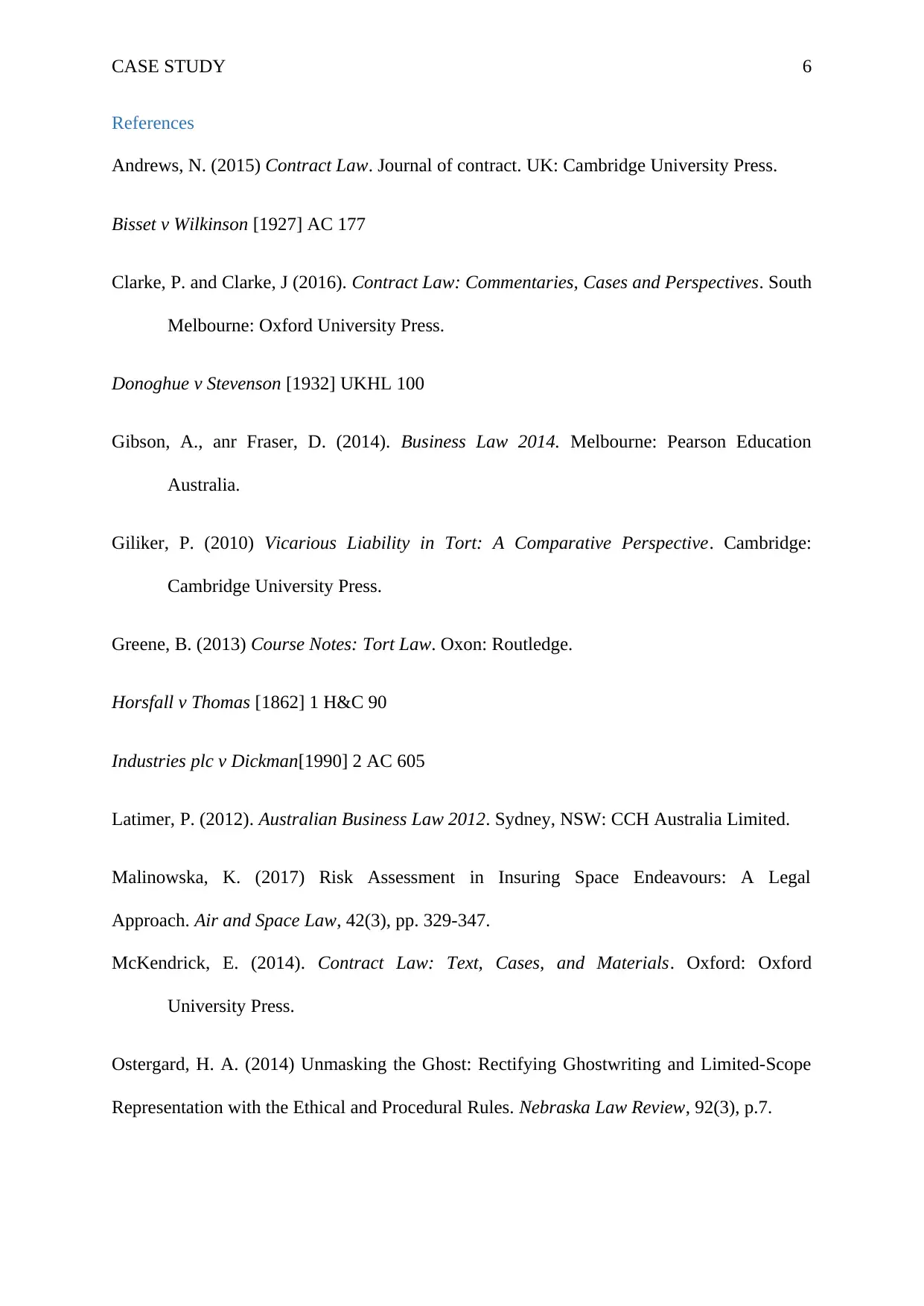
CASE STUDY 6
References
Andrews, N. (2015) Contract Law. Journal of contract. UK: Cambridge University Press.
Bisset v Wilkinson [1927] AC 177
Clarke, P. and Clarke, J (2016). Contract Law: Commentaries, Cases and Perspectives. South
Melbourne: Oxford University Press.
Donoghue v Stevenson [1932] UKHL 100
Gibson, A., anr Fraser, D. (2014). Business Law 2014. Melbourne: Pearson Education
Australia.
Giliker, P. (2010) Vicarious Liability in Tort: A Comparative Perspective. Cambridge:
Cambridge University Press.
Greene, B. (2013) Course Notes: Tort Law. Oxon: Routledge.
Horsfall v Thomas [1862] 1 H&C 90
Industries plc v Dickman[1990] 2 AC 605
Latimer, P. (2012). Australian Business Law 2012. Sydney, NSW: CCH Australia Limited.
Malinowska, K. (2017) Risk Assessment in Insuring Space Endeavours: A Legal
Approach. Air and Space Law, 42(3), pp. 329-347.
McKendrick, E. (2014). Contract Law: Text, Cases, and Materials. Oxford: Oxford
University Press.
Ostergard, H. A. (2014) Unmasking the Ghost: Rectifying Ghostwriting and Limited-Scope
Representation with the Ethical and Procedural Rules. Nebraska Law Review, 92(3), p.7.
References
Andrews, N. (2015) Contract Law. Journal of contract. UK: Cambridge University Press.
Bisset v Wilkinson [1927] AC 177
Clarke, P. and Clarke, J (2016). Contract Law: Commentaries, Cases and Perspectives. South
Melbourne: Oxford University Press.
Donoghue v Stevenson [1932] UKHL 100
Gibson, A., anr Fraser, D. (2014). Business Law 2014. Melbourne: Pearson Education
Australia.
Giliker, P. (2010) Vicarious Liability in Tort: A Comparative Perspective. Cambridge:
Cambridge University Press.
Greene, B. (2013) Course Notes: Tort Law. Oxon: Routledge.
Horsfall v Thomas [1862] 1 H&C 90
Industries plc v Dickman[1990] 2 AC 605
Latimer, P. (2012). Australian Business Law 2012. Sydney, NSW: CCH Australia Limited.
Malinowska, K. (2017) Risk Assessment in Insuring Space Endeavours: A Legal
Approach. Air and Space Law, 42(3), pp. 329-347.
McKendrick, E. (2014). Contract Law: Text, Cases, and Materials. Oxford: Oxford
University Press.
Ostergard, H. A. (2014) Unmasking the Ghost: Rectifying Ghostwriting and Limited-Scope
Representation with the Ethical and Procedural Rules. Nebraska Law Review, 92(3), p.7.
Paraphrase This Document
Need a fresh take? Get an instant paraphrase of this document with our AI Paraphraser
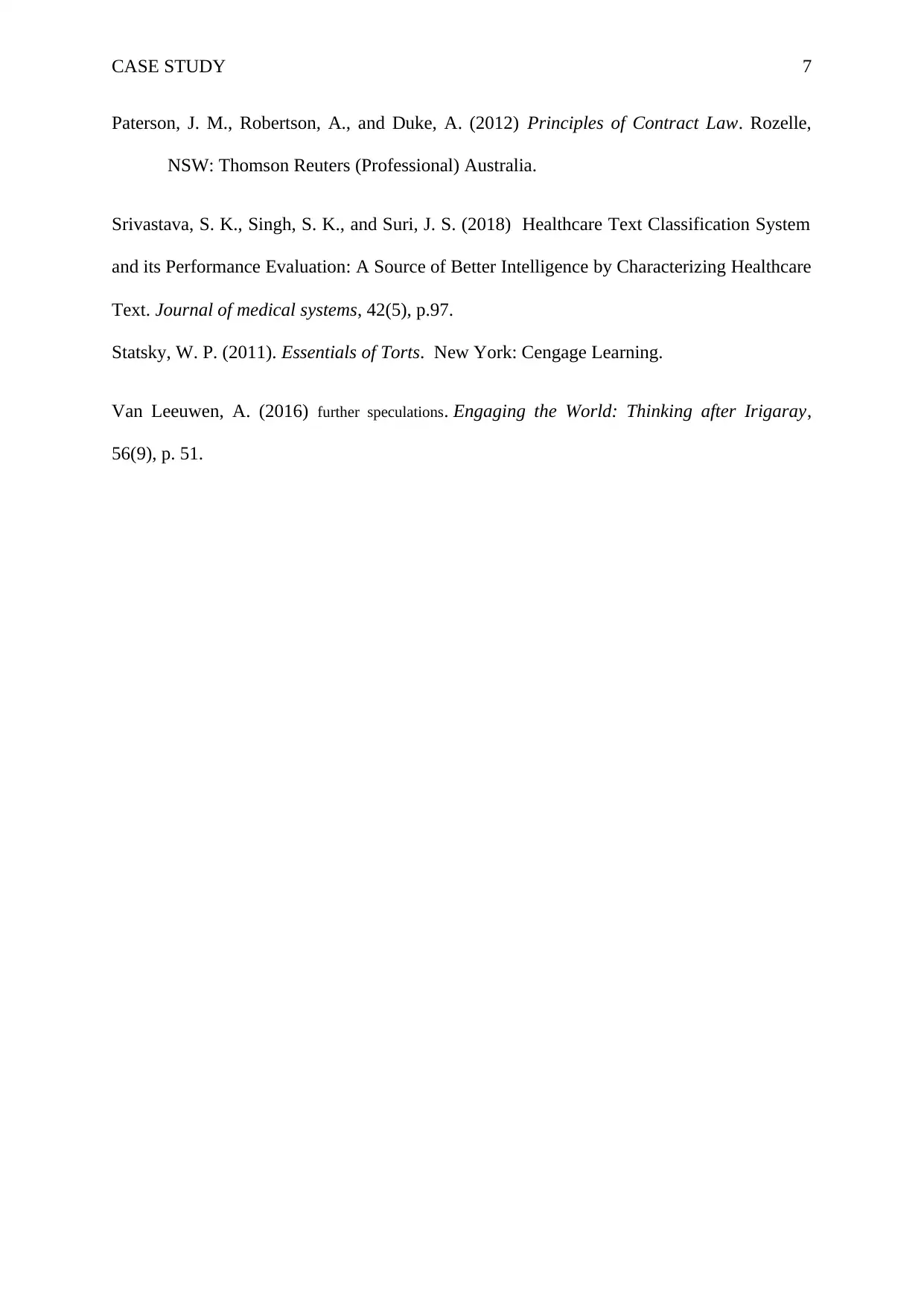
CASE STUDY 7
Paterson, J. M., Robertson, A., and Duke, A. (2012) Principles of Contract Law. Rozelle,
NSW: Thomson Reuters (Professional) Australia.
Srivastava, S. K., Singh, S. K., and Suri, J. S. (2018) Healthcare Text Classification System
and its Performance Evaluation: A Source of Better Intelligence by Characterizing Healthcare
Text. Journal of medical systems, 42(5), p.97.
Statsky, W. P. (2011). Essentials of Torts. New York: Cengage Learning.
Van Leeuwen, A. (2016) further speculations. Engaging the World: Thinking after Irigaray,
56(9), p. 51.
Paterson, J. M., Robertson, A., and Duke, A. (2012) Principles of Contract Law. Rozelle,
NSW: Thomson Reuters (Professional) Australia.
Srivastava, S. K., Singh, S. K., and Suri, J. S. (2018) Healthcare Text Classification System
and its Performance Evaluation: A Source of Better Intelligence by Characterizing Healthcare
Text. Journal of medical systems, 42(5), p.97.
Statsky, W. P. (2011). Essentials of Torts. New York: Cengage Learning.
Van Leeuwen, A. (2016) further speculations. Engaging the World: Thinking after Irigaray,
56(9), p. 51.
1 out of 8
Related Documents
Your All-in-One AI-Powered Toolkit for Academic Success.
+13062052269
info@desklib.com
Available 24*7 on WhatsApp / Email
![[object Object]](/_next/static/media/star-bottom.7253800d.svg)
Unlock your academic potential
Copyright © 2020–2025 A2Z Services. All Rights Reserved. Developed and managed by ZUCOL.




